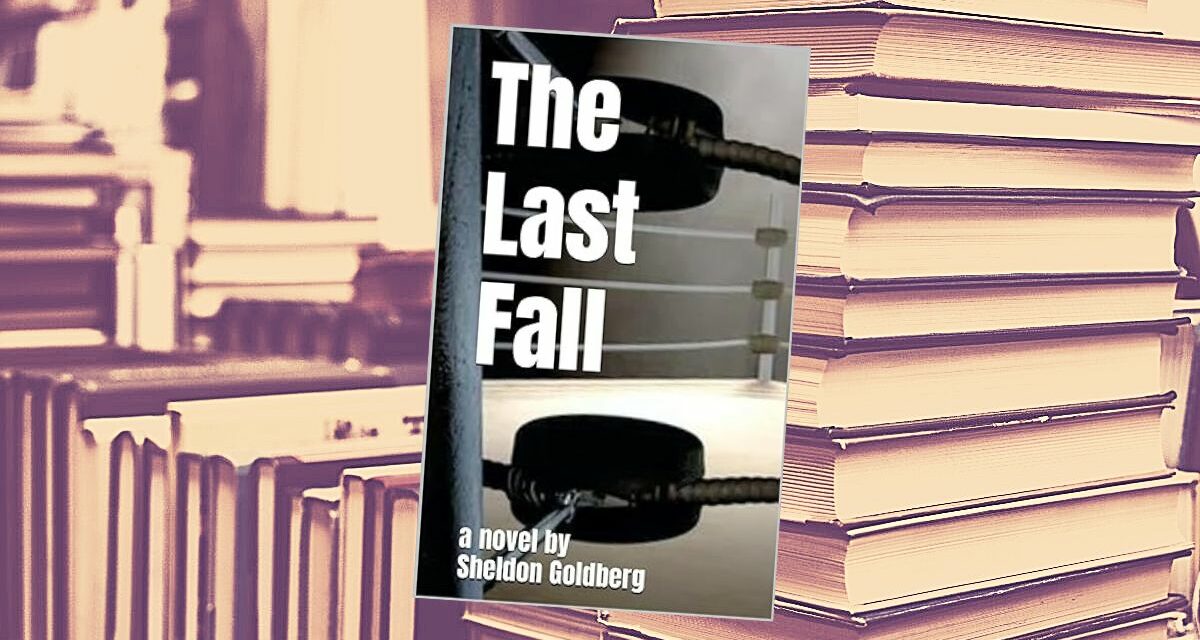After facing some serious health issues after the 2022 Cauliflower Alley Club (CAC) reunion, not to mention a pandemic, Boston’s Sheldon Goldberg felt he needed a new creative outlet. As a result, the promoter and founder of New England Championship Wrestling (NECW) has just released his first self-published novel, The Last Fall. The book tells the story of fictional wrestler Rick Pacheco from 1971 to 1999 with the prevalent theme on the changes that occur in the pro wrestling business. Goldberg says his goal for the book was “to deftly dance between real life and fiction.” Here is our conversation about his first foray into authorhood:
Jamie Hemmings: So, I thought to start, we could talk a little bit about your educational and career background because I wanted to learn more about you.
Sheldon Goldberg: All right. Well, I went to the University of Mass (Massachusetts). I was a theater major. Of all things, as crazy as that sounds. I had a career in theater before I got involved in pro wrestling. I did publicity for Broadway shows on tour and local productions. And then I became a producer.
JAMIE: Well, I guess wrestling is sort of theatrical. So maybe that was a good transition.
SHELDON: Yeah I mean, you know, different kinds of tights.

Sheldon Goldberg. Photo credit: NECW
JAMIE: So how did you become a wrestling fan? And why are you a wrestling fan?
SHELDON: I first noticed wrestling on TV when I was about eight years old. It was on TV locally. And you know, I just thought that pro wrestlers were like superheroes come to life. And my favorite part of pro wrestling was the interviews. At least in this part of the country the pro wrestling TV show was basically squash matches and interviews to try to get you to come to an arena to see the more competitive matches. So the best part of the show for me was the promos. The localized promos.
JAMIE: Who was your favorite wrestler growing up?
SHELDON: Bruno Sammartino.
JAMIE: Okay, and why?
SHELDON: Well, I think you had to live through that era to really appreciate Bruno Sammartino. He had such a bond with the people because he was so legit looking and carried himself as a legitimate athlete, and he legitimately was one of the strongest men in the world at one point in his time. And you know, he was so idolized by so many people, you know, starting with, you know, Italian immigrants and Latin immigrants and so forth. Immigrant people looked at Bruno as the coming to America success story come to life. He was literally like the Charles Atlas story, in the form of an Italian he came to the United States as a way of escaping the Nazis and coming to America with his mother, and a kid with rheumatic fever and who had all kinds of health problems and then built himself up to be one of the strongest men in the world. The epitome of what a wrestling world champion should look like. If you ever saw that that classic picture of Bruno Sammartino looking like a bear with his championship belt on, that screamed the World Heavyweight Champion.
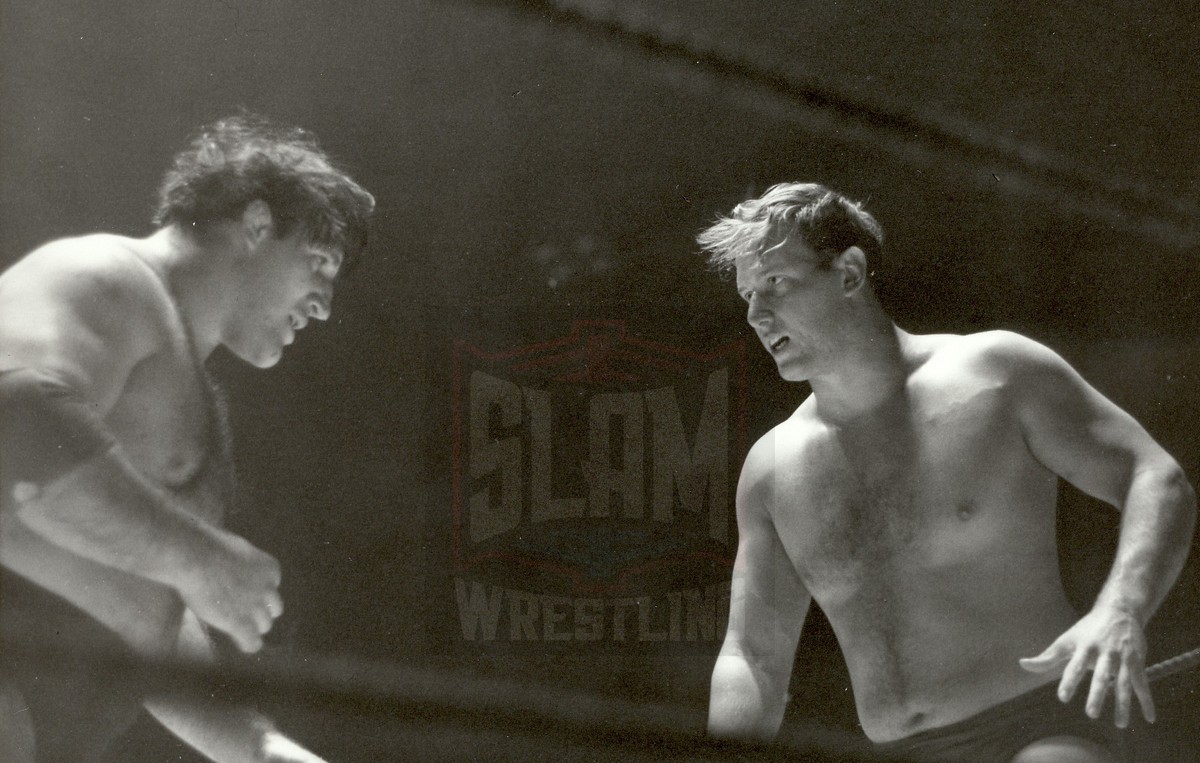
Bruno Sammartino takes on Johnny Powers. Photo by Roger Baker
JAMIE: Who do you like to watch today?
SHELDON: Hmm. Well, that’s a complicated question to answer, because I like to watch a lot of different things. I watch some WWE (World Wrestling Entertainment), but not much. I’ll watch the pay-per-views to kind of see what’s been going on and so forth. I watch a lot more AEW (All Elite Wrestling), only because I find the young kids interesting. Having been an independent promoter for many years, a lot of those talents are guys from the independents so they’re a little closer to my experience. Some of them I know.
JAMIE: What’s that like when you’ve seen pro wrestlers in the early days and you see them go on to WWE or AEW? What’s that like for you?
SHELDON: Oh, man, it’s great. I knew that was my lot in life. I knew that was the situation. You know, my station in the wrestling business was the kind of a person that held the curtain open while people pass through. And I had a lot of people work for me over the years, who became very big stars in pro wrestling. John Cena, Kofi Kingston, I gave England’s Doug Williams his first match in the United States, gave Becky Lynch her first match in the United States. So I’ve had a lot and I’m proud of all those people, I don’t take any credit for their careers, I only consider myself fortunate to have had the ability to work with them and give them a place to apply their craft.
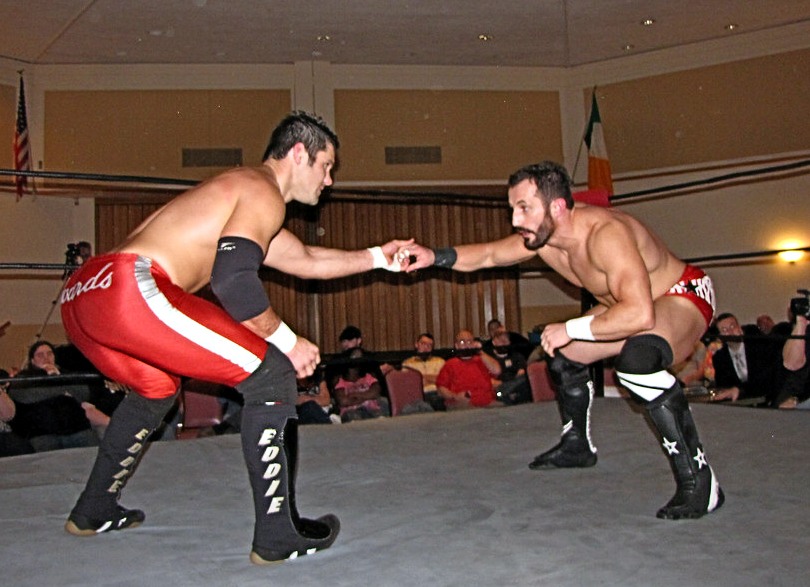
Eddie Edwards and Bobby Fish competing in NECW. Photo courtesy NECW
JAMIE: So you promoted and founded New England Championship Wrestling, how did this promotion come about? And what were your goals with that promotion?
SHELDON: Well, before that, I was involved with the late Boston Bad Boy Tony Rumble. He had a promotion locally called the Century Wrestling Alliance, which later became NWA New England. And we became very close. And we worked together on that for six or eight years. And he died suddenly, in November of 1999, from a massive heart attack. And after that, I wasn’t sure what direction I was going to go and his widow wanted to take the business in a direction that I didn’t think it should go. So we sort of amicably parted ways, and I started doing New England Championship Wrestling.
My goal was, is to be your friendly neighborhood wrestling promotion plus. By plus, I mean keeping the door open to people from outside the area that come in and we had regulars and we had semi regulars. And some of those semi-regular people I mentioned Doug Williams. Oh I didn’t get a chance to mention Beth Phoenix (also wrestled for the promotion).
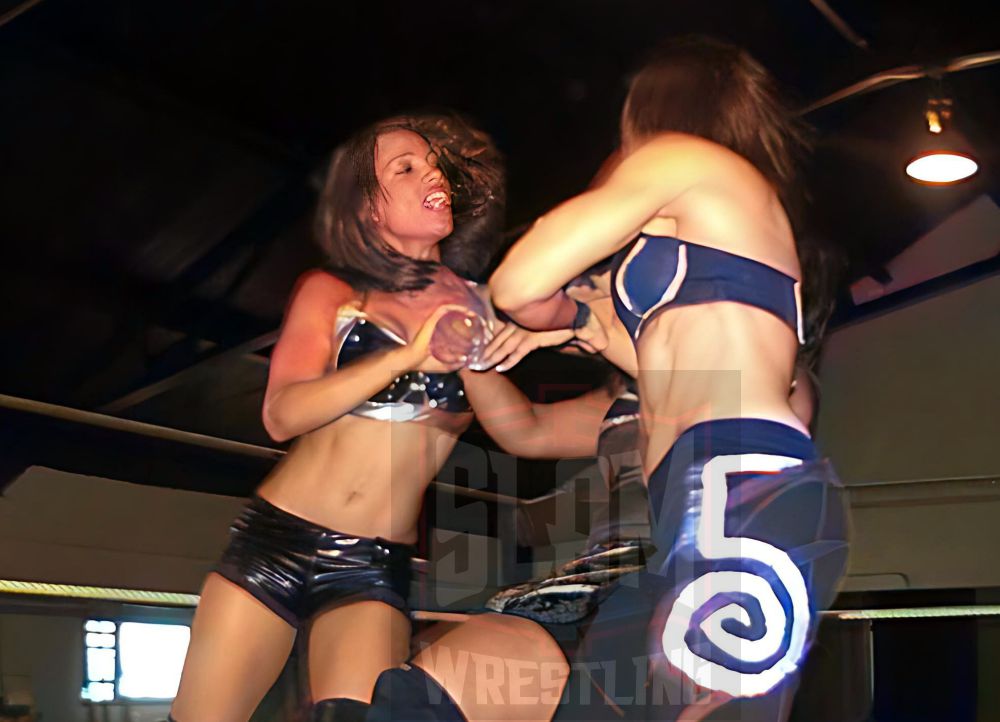
Mercedes Varnado — later known as Sasha Banks and Mercedes Mone — competing in NECW. Photo courtesy NECW
JAMIE: And Sasha Banks!
SHELDON: Sasha Banks had her first professional match in NECW. So I like to tell people that I was very fortunate to work with all these folks. It was very fortunate to be able to give them a stage to perform on. We were producing content. By content, I mean, something that resembled television, we started in 2004, producing an online TV show. And, yeah, before there was a YouTube, it was pretty rudimentary, but it improved over time. And that was a chance for people to not just perform, but to do promos and do angles and so forth, and really develop them as talents on a fuller level.
JAMIE: What is the current status of that promotion?
SHELDON: Well, we stopped running live events pretty much through the pandemic. And I’ve had some health issues over the last few years. Six years ago, I shattered my right shoulder on a fall. I recovered from that. I’m doing fine. But you know, I had gotten to the point where I was 60 years old. (He’s now 67 years old.) Now I’m staying well, maybe I ought to slow down. So I stopped running as frequently. I was just doing basically fundraising shows that people would approach me to do and then about 14 months ago, I had an issue I was on a flight back from Las Vegas (at CAC) to Boston and my kidneys failed on the flight. It was a very trying time.
JAMIE: So how long was that recovery process?
SHELDON: I was in the hospital for about a month. So now I’m on dialysis. (Goldberg is currently on dialysis three times a week from 6 a.m. – 10 a.m., and hoping to get a kidney transplant.) At the end of my hospitalization, I went back to my regular job (at a health insurance company). I did that for six months, but I decided when I was in the hospital that I was going to come up with kind of an end date for that and focus on more creatively fulfilling projects. The book, The Last Fall, being one of them. So, I went back to work and I worked for about six months and then I retired last May from that job.
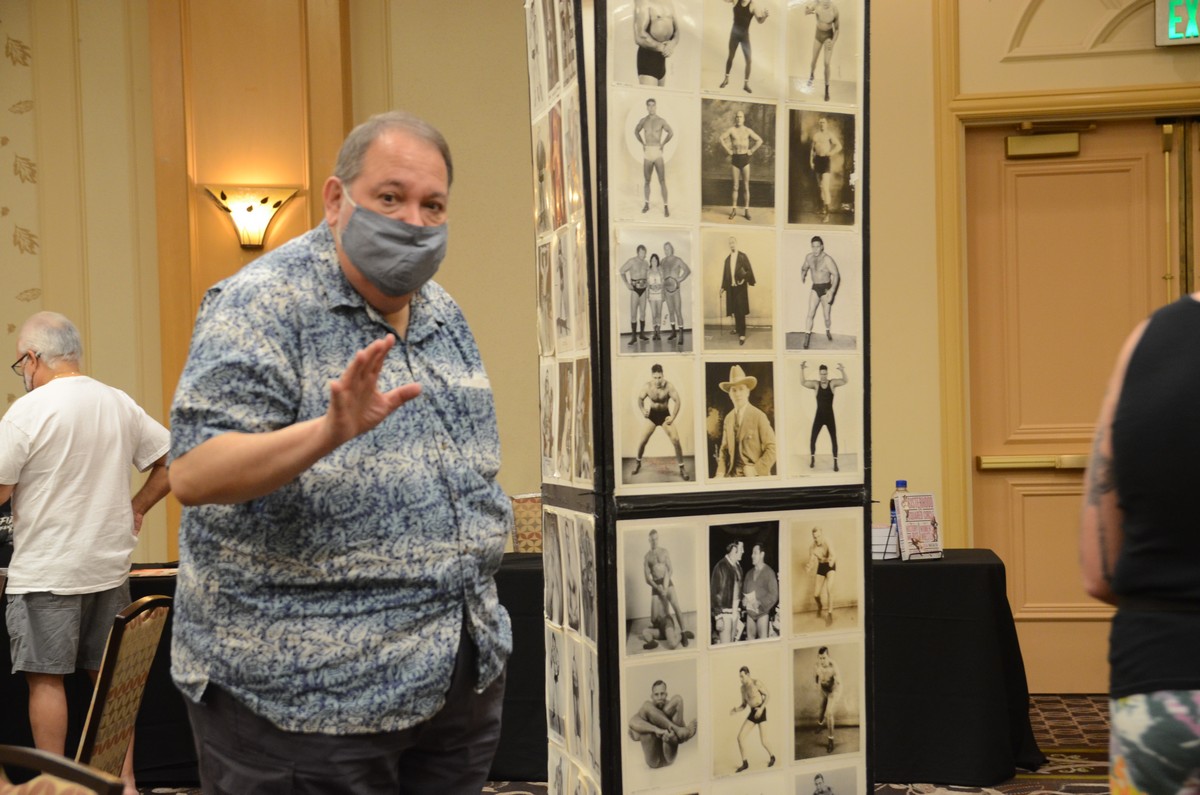
Promoter Sheldon Goldberg at the Cauliflower Alley Club reunion at the Gold Coast Hotel & Casino in Las Vegas, Nevada, Monday, September 13, 2021. Photo by Brad McFarlin
JAMIE: Tell me about how long it took to complete your first novel. Where did the inspiration come from?
SHELDON: I was writing a completely different story which I will probably get back to at some point. But I was about 100 pages in and then I just got this idea that became The Last Fall. And it was one of those things where I saw the whole thing. I just had this really clear picture of the entire plot, and what would be in it, and so forth. And so I put that first project aside, and went right into writing The Last Fall and the first draft was finished in three weeks. As crazy as that sounds, right?
I wasn’t sure I was going to be able to write a novel. It’s something that I always wanted to try, but never had the time to do it. When you promote wrestling, and you have a regular job, and you try to have a life on top of that, that’s pretty much the whole ball of wax timewise, you don’t have time to do much of anything else. When I got out of the hospital, I was working 40 hours a week and doing 12 hours a week with dialysis. That 52 hours was pretty grueling. So part of my decision to retire, although I had made the decision when I was in the hospital, but it was just confirmed to me that 52 hours a week is a big chunk of time, I had no time for anything else. I tried to get NECW back going. I was a little disappointed and not being able to marshal all the resources to be able to do that. And I didn’t want to go back to doing it unless I could do it correctly. And do it in the way that I really wanted to do it. And so I said, alright, well, there’s got to be other stuff I can do. Let’s try to write a novel. Here we go.
JAMIE: So, there aren’t a lot of pro wrestling themed novels. I’m wondering why you decided to write a novel, as opposed to a nonfiction pro wrestling book.
SHELDON: I don’t rule out writing a nonfiction pro wrestling book at some point in time. But the big reason that I wrote this and the big reason I wanted to attempt it is that I’ve seen a lot of movies and television shows and so forth, that try to portray professional wrestling, but they never get the business of it right. They never really capture the experience in any sort of a truthful way. It’s like a Hollywood writer trying to write about wrestling is like a Hollywood writer trying to write about doing brain surgery. I mean, yeah, you may be able to get some of the facts right, but the experience of it, unless you’ve done it will elude you. So I wanted to write a story that kind of gave people, with it still being fictional, the feel of what it was like to be a professional wrestler, particularly in this particular period of time, from 1971 to 1999, which is really a critical period in pro wrestling history. And one guy’s journey through all of that.
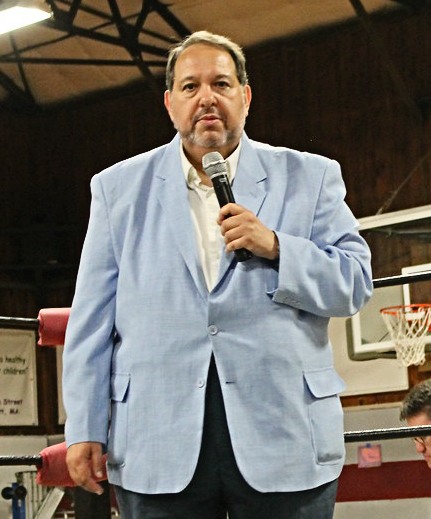
Sheldon Goldberg as ring announcer in NECW. Photo courtesy NECW
JAMIE: You use some names in the book that wrestling fans are going to recognize, but other characters are, of course, fictional. I was wondering if you can tell us about some of the real-life people who inspired some of the characters in the book?
SHELDON: Well, the characters in the book, the main characters are amalgamations of different people. Some of them are just totally made up. Some of them, it’s pretty clear who they are. I’ll let people read it and figure it out for themselves. But others are just amalgamations of people or people that I wish had existed in the positions that they occupy in the book. You know, there’s a lot of rebooking of wrestling history in this novel. I sort of take wrestling history and kind of twist it the way I wish that it were, as opposed to the way that it actually was.
JAMIE: Did you consult anyone involved in pro wrestling before writing the book?
SHELDON: No. I’ve been around long enough. So it wasn’t like I had to do a prolonged amount of research on the book. I just sort of wrote it from things that I knew. Having good historical knowledge and having a command of history, helps you bend it and twist it, where you need it to go in a fictional book.
JAMIE: I felt that the theme that resonated in the book was how pro wrestling has changed over the years. So I’m wondering what changes in pro wrestling do you feel were positive? And which ones did you feel were negative?
SHELDON: I think the biggest change in pro wrestling in that period that the book covers, is the rise of what I like to call corporate wrestling. The big corporations like WWE and AEW now, but before, TBS, Turner Broadcasting and so forth. So wrestling kind of lost a little bit of its small-town innocence in that period because the money was too great. Instead of these wrestling territories that would run big buildings in big cities, but then do spot shows in smaller venues, the smaller venues went away, because they just financially weren’t worth doing. Now, why run a 1,400, 1,500 seat building in a little town when you can run the 20,000-seat arena, and gross 10 times the money? So those kinds of shows disappeared, and in many cases, and in many parts of the country, they never came back. Because there was nobody to fill that that gap. Independent wrestling came along. And you know, a lot of independent shows, very few of them occupied buildings that are that big. Most of them you find in, you know, VFW halls and armories, and so forth, and you’re talking about a few hundred people, but that mid-size building that 1,000 seats, 1,500 seats, 2,000 seats, that went away. And I think that the business misses that.
JAMIE: What do you want readers to take away from your book?
SHELDON: I just want them to enjoy the story. The story of one person’s journey through a pretty crazy business with a lot of ups and downs and a lot of emotional turmoil. But in the end, there’s a story of redemption and that redemption comes in assisting others rather than assisting himself. And when I finished the book, I was really happy with it. I thought this was pretty good. I was afraid that other people wouldn’t think so. But, you know, once I put it out there, it is what it is. People are going to like it or they’re not gonna like it. And I’ll live with whatever the consequences are. Having been a theater producer, and having had hits and having had flops. You learn not to take anything personally. So I had no fear when the book came out. But again, I was very happy with it personally.
JAMIE: Do you have plans to write more books?
SHELDON: Yeah, absolutely. This was the most satisfying creative experience I’ve ever had. Because it was a different creative experience. When you produce a play, or when you promote wrestling, you might be the person behind it. But when the moment of truth comes, all you can do is stand at the back and watch. Whereas when you write a book, the whole thing is in your hands from soup to nuts. This is the book that I wanted to write.
JAMIE: Those are the questions I had, Sheldon. But if there was anything you wanted to add, or anything I missed?
SHELDON: I liked helping other people grab that brass ring. Even if it was only locally, even if it was only for a minute, even if they were only on local TV as opposed to national TV. That was something that I got a lot of a lot of satisfaction over. I just felt that’s a noble role to have in a business like this. Besides I don’t look very good in tights!
This interview has been edited for length and clarity.
RELATED LINKS
- Buy The Last Fall at Amazon.com or Amazon.ca
- Sheldon Goldberg: Website, Facebook, and Twitter
- SlamWrestling Master Book List
- Past Sheldon Goldberg stories at SlamWrestling.net
